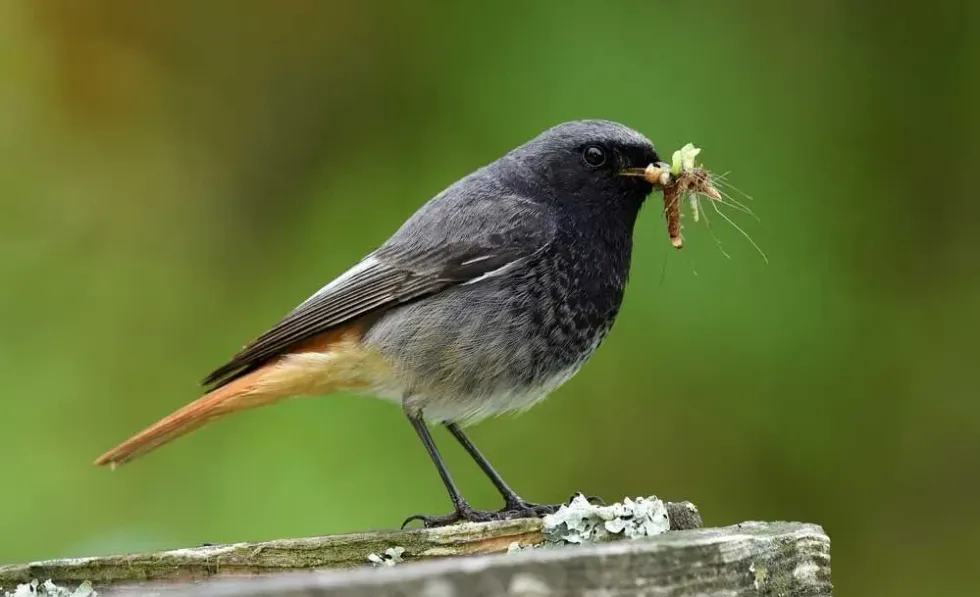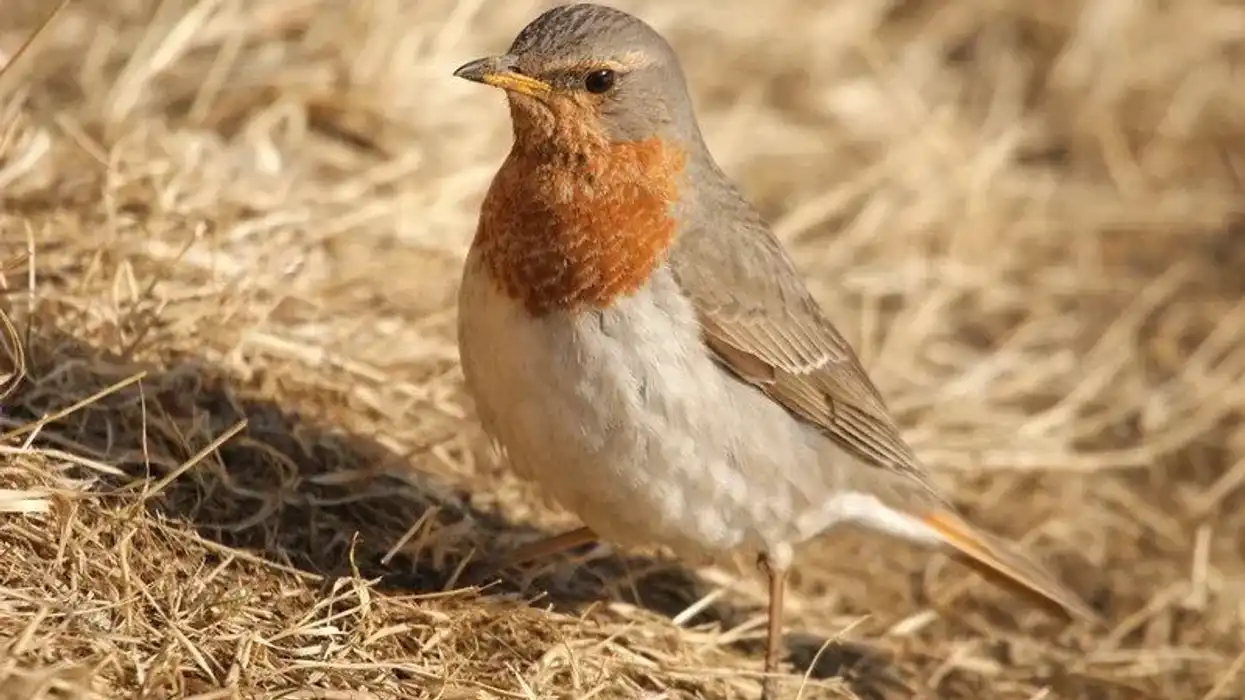Do you enjoy traveling? Well, so does the black redstart!
Do not be fooled by the small description of this robin-sized bird, for it has enough stamina to make a migratory trip from its summer home in Britain to South and Central India in the winter.
Though this bird is mostly concentrated in the urban buildings of Britain, London in the summers, its population has seen a concerning decline in the years.
However, it is still not considered endangered because, in addition to being on-site at industrial areas in cities, these birds are also very prevalent in the rural towns and small villages all across Britain.
They also have a very prominent description, making them easy to recognize whether you see them in the summer or the winter. They have a gray-colored plumage, and sport the prominent black redstart white crest, with the males slightly bigger than the females.
Read on to know more about these wonderful birds, their travels from the summer to the winter, and do not forget to check out other awesome birds like the little bee-eater and the blue jay.
Black Redstart Interesting Facts
What type of animal is a black redstart?
Black redstart (Phoenicurus ochruros) is a type of bird.
What class of animal does a black redstart belong to?
This European resident bird species belongs to the class Aves.
How many black redstarts are there in the world?
The black redstart is on the Birds of Conservation Concern's Red List in London (UK), with fewer than 100 breeding pairs. Between 10-30% of the nationwide breeding population is concentrated in London. However, world population data is not available. The European robin ( Family: Turdidae) has a population of about 200 million birds around the world.
Where does a black redstart live?
They live in woods. Though they also favor urban landscapes and will be found close to a lot of human habitation. However, such is not the case with these creatures on the other side of the Atlantic, where in Asia and other locations like this, they are usually found favoring coniferous forests.
What is a black redstart's habitat?
The majority of black redstart species are found in southern England, where they favor rocky habitats such as those found in docklands, towns, buildings, and industrial areas. The black redstart is a year-round inhabitant throughout Portugal.
The Himalayan black redstart species breed in the Himalayas, Central Asia, and East Asia spend the winter in India, primarily in Northern and Central India.
Painted redstarts are found in the south of the United States, southern Mexico, and northern Latin America.
Who do black redstarts live with?
This species of birds is mainly solitary in winter. These birds can be found in pairs or groups of up to five to six at places with a more plentiful food supply. During the breeding season, they form pairs.
How long does a black redstart live?
Black redstart (Phoenicurus ochruros) birds survive for an average of two years, but this species can survive for up to 10 years.
How do they reproduce?
Depending on the range, the breeding season differs. This European resident bird builds a cup-shaped nest in cavities and holes and stacks of stones on the ground. Grass, hair, or feathers are used to construct the nest. Four to six whitish eggs are laid by the black redstart female.
The female alone is responsible for incubation, which takes 12-13 days. They are mostly fed insects by breeding pairs. The youngsters depart the nest 12-17 days following hatching. Each year, the breeding pairs produce two broods.
Throughout the breeding season, the black redstart male sings according to the different situations. The adult male black redstart sing-song when appearing on breeding regions and setting the territory. Males also chirp to attract a female back redstart and till the start of the nest construction.
The adult male black species choose the nest-site, although the female black redstart makes the nest. Until the egg-laying, the male remains relatively silent. At the time of incubation period, males sing once more till the chicks hatch.
What is their conservation status?
The conservation status of this robin-sized bird is listed as of Least Concern by the IUCN Red List.
Black Redstart Fun Facts
What do black redstarts look like?

Adult black redstart males have slate-gray plumage on the upper parts and crest, including dark shade on the wings. The color of flight feathers is dark gray to black tint with white borders, making a white spot when wings are folded.
Rump has a red-orange in color, the breast is blackish, flanks and belly are slaty-gray. Undertail feathers and lower belly of adult male black species are red-orange.
The eastern black redstart female is gray-brown overall but has a rump and tail that is colored orange-red. It is, however, still on the grayer side as opposed to other species like the common redstart.
The rufous-backed robin, a mature bird, gets a rufous, reddish-brown, or olive-rufous upper back, with a grayish head, nape, and rump, as the name suggests. Their breast and side are grays as well, although their youngsters are brown.
How cute are they?
The black redstart bird is one of the rarest and most fascinating breeding passerines. These spring passage migrant redstarts with spotted wings, black breast, gray belly, and plumage look cute.
How do they communicate?
The European black redstart communicates with the different sounds when alarmed, territorial defense, courtship displays, and fights. It gives a hard sound when the bird is really threatened.
How big is a black redstart?
The size of this bird species is about 5.1–5.7 in (13–14.4 cm) long. In comparison, American redstarts length measures up to 4.3-5.5 in (11-14 cm). Black redstarts are a little bit bigger than American species.
How fast can a black redstart fly?
The black redstart flies quickly and powerfully. It has the ability to collect insects by flycatching.
How much does a black redstart weigh?
The weight range of this gray-black bird species is about 0.42–0.71 oz (12–20.1 g).
What are the male and female names of the species?
There is no particular name for black redstart females and males.
What would you call a baby black redstart?
There is no special title for a baby of black red-tail species, who mostly find a habitat in industrial areas.
What do they eat?
Grasshoppers, lepidopteran insects, bugs, ants, beetles, bees, spiders, earthworms, and small mollusks are among the invertebrates that black redstart eats. This bird, found in buildings and industrial areas, eats fruits, berries, and seeds. Their diet may differ depending on where they are. It descends to the ground to forage, hopping around in search of prey.
Are they poisonous?
No, they are not poisonous.
Would they make a good pet?
There is insufficient information about the captivity of these species, which was previously a member of the family Turdidae; however, it is currently recognized as an Old World flycatcher.
Did you know...
Spring passage migrants and breeding birds come between March-May. While autumn passage continues from September-November, rising in October.
During late autumn through early spring, black redstart winter birds can be found. There is a great spring passage of black redstarts in Ireland and the UK. In locations such as the Islands of Scilly and Cornwall, they can be quite abundant during their autumn passage.
A small number can be found in the winter from Lincolnshire southwards and Lancashire and around the South Shore. A few birds reproduce in southeast England.
Black redstart is a mountain species that has acclimated to cities, villages, and towns throughout its core range throughout Europe, and the song of this European bird is a typical background sound. Records show that people tried to breed black redstarts in Manchester between 1992 and 1997.
If you ever look at the black redstart definition, you will find that the group's name has a common etymology compared to other birds.
What is special about black redstarts?
These redstarts have a unique orangish tail most visible when the wing is flared out or in flight. Western birds have a darker appearance; the males are slate-black, while the female is smoky grayish. Eastern males birds have a lot of orange on their underbelly, while females have a warm brown color.
The secondaries have pale fringes, creating a whitish panel, and the wings are blackish-gray. The western subspecies' white wing strip does not appear till the second year. Both species have an orangish-red tail and black breast.
Are black redstarts endangered?
Inside the black redstart range, it is rather common. At present, this species is not considered to be globally endangered. The black redstart is an urban bird that is surprisingly prevalent in villages and towns across Europe.
Here at Kidadl, we have carefully created lots of interesting family-friendly animal facts for everyone to discover! For more relatable content, check out these Amazon parrot facts and brant facts for kids.
You can even occupy yourself at home by coloring in one of our Black redstart coloring pages.










